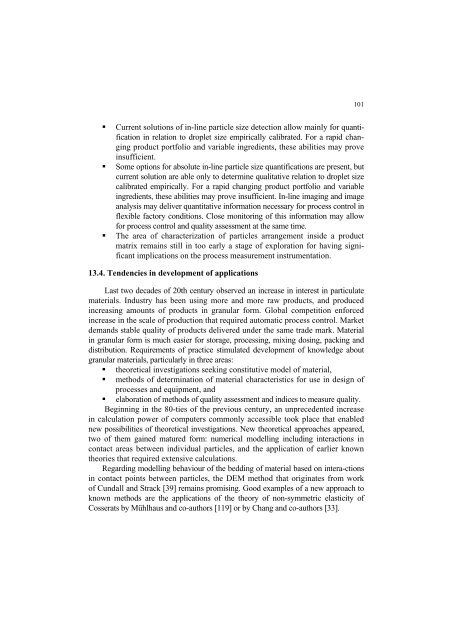Strona 2_redak - Instytut Agrofizyki im. Bohdana DobrzaÅskiego ...
Strona 2_redak - Instytut Agrofizyki im. Bohdana DobrzaÅskiego ...
Strona 2_redak - Instytut Agrofizyki im. Bohdana DobrzaÅskiego ...
You also want an ePaper? Increase the reach of your titles
YUMPU automatically turns print PDFs into web optimized ePapers that Google loves.
101<br />
ƒ Current solutions of in-line particle size detection allow mainly for quantification<br />
in relation to droplet size empirically calibrated. For a rapid changing<br />
product portfolio and variable ingredients, these abilities may prove<br />
insufficient.<br />
ƒ Some options for absolute in-line particle size quantifications are present, but<br />
current solution are able only to determine qualitative relation to droplet size<br />
calibrated empirically. For a rapid changing product portfolio and variable<br />
ingredients, these abilities may prove insufficient. In-line <strong>im</strong>aging and <strong>im</strong>age<br />
analysis may deliver quantitative information necessary for process control in<br />
flexible factory conditions. Close monitoring of this information may allow<br />
for process control and quality assessment at the same t<strong>im</strong>e.<br />
ƒ The area of characterization of particles arrangement inside a product<br />
matrix remains still in too early a stage of exploration for having significant<br />
<strong>im</strong>plications on the process measurement instrumentation.<br />
13.4. Tendencies in development of applications<br />
Last two decades of 20th century observed an increase in interest in particulate<br />
materials. Industry has been using more and more raw products, and produced<br />
increasing amounts of products in granular form. Global competition enforced<br />
increase in the scale of production that required automatic process control. Market<br />
demands stable quality of products delivered under the same trade mark. Material<br />
in granular form is much easier for storage, processing, mixing dosing, packing and<br />
distribution. Requirements of practice st<strong>im</strong>ulated development of knowledge about<br />
granular materials, particularly in three areas:<br />
ƒ theoretical investigations seeking constitutive model of material,<br />
ƒ methods of determination of material characteristics for use in design of<br />
processes and equipment, and<br />
ƒ elaboration of methods of quality assessment and indices to measure quality.<br />
Beginning in the 80-ties of the previous century, an unprecedented increase<br />
in calculation power of computers commonly accessible took place that enabled<br />
new possibilities of theoretical investigations. New theoretical approaches appeared,<br />
two of them gained matured form: numerical modelling including interactions in<br />
contact areas between individual particles, and the application of earlier known<br />
theories that required extensive calculations.<br />
Regarding modelling behaviour of the bedding of material based on intera-ctions<br />
in contact points between particles, the DEM method that originates from work<br />
of Cundall and Strack [39] remains promising. Good examples of a new approach to<br />
known methods are the applications of the theory of non-symmetric elasticity of<br />
Cosserats by Mühlhaus and co-authors [119] or by Chang and co-authors [33].
















